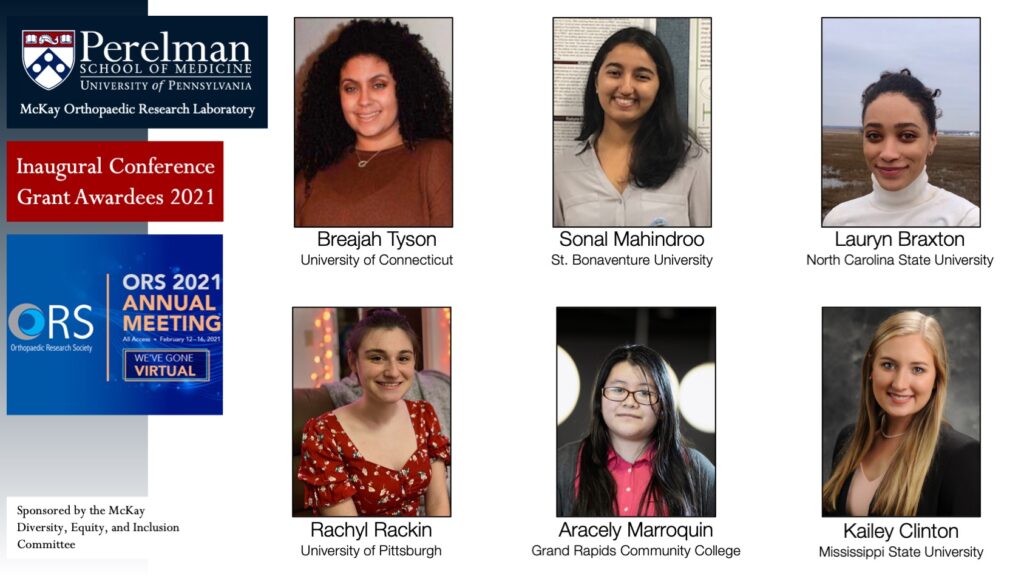Congratulations to AJ, Joella, and Aituaje, who were both selected as Abrams scholars for the 2019-2020 academic year.
AJ will be continuing on his independent research project:
Comparison of grafts for adolescent ACL reconstruction: Adolescent anterior cruciate ligament (ACL) injuries are becoming more common in recent years due to an increase in adolescents’ sports participation. The type of ACL reconstruction surgery that is appropriate for each injury depends on multiple variables, including age, severity of damage, and the surgeon’s preference. One common treatment approach involves removing the damaged ACL and replacing it with a surgical graft. Comparison studies have been conducted for adult populations receiving surgical grafts, however there is a lack of available data adolescent populations. This project involves developing a testing protocol to measure viscoelastic properties of grafts in a physiological environment. Once a protocol has been established, a graft comparison study using a growing porcine model will be conducted. The study will test the mechanical differences between various grafts at different ages (for example, hamstring tendons, bone-patella tendon-bone, etc.) to better choose which graft may be most appropriate in the adolescent population.
Aituaje will continue working with Zack on a project that she began over the summer:
Effect of material and 3D printing parameters on replicating the structure and mechanical properties of the meniscus: The meniscus is a load-bearing tissue in the knee with complex geometry. Treatment of injuries to the meniscus often lack patient-specific size matching. Fused Deposition Modelling (FDM) is a 3D printing technique that melts a thermoplastic then extrudes it in the form of small fibers in a layer by layer manner. This allows us to create complex shapes controlled by computer-guided code. This project aims to apply FDM as a tool to replicate patient-specific geometries, assessed from MRI scans, while matching the meniscus’s mechanical properties by varying materials and printing parameters. The student will perform tensile and compressive testing on 3D printed samples to analyze their mechanical properties.
And Joella will continue working with Danielle:
Characterizing the microstructure of the ACL throughout skeletal growth:
The anterior cruciate ligament (ACL) connects the femur to the tibia, and functions as a major stabilizer in the knee joint. Injury and surgical reconstruction of the ACL in pediatric patients are rapidly increasing, but these surgeries result in 4-6 times higher secondary injury rates compared to these surgeries in adults. Further, females are at a much higher risk of ACL tear than males during adolescence but not childhood or adulthood. The ligament is largely hypocellular and is composed mainly of aligned collagen, but little data is available regarding its specific microstructure throughout growth. This project will aim to histologically examine the microstructural properties of the ACL in males and females throughout skeletal growth. Results from this project will help us understand what might contribute to the disparity in injury rates between males and females throughout growth. Further, this data can be applied to help inform the development of sex- and age-specific tissue engineered ligaments.
About the Abrams Scholars Program:
Abrams Scholars are outstanding BME undergraduate students who are selected to receive a stipend to conduct hands-on laboratory research projects. These projects are conceived and designed by the students with the guidance of a faculty mentor. The Abrams Scholar program honors C. Frank Abrams, Jr., a BME and BAE emeritus faculty member. Dr. Abrams led the development of the first courses in Biomedical Engineering at NC State and was instrumental in the founding of NC State’s BME Department, the creation of the joint UNC-CH/NC State graduate program, and ultimately the launch of the UNC-CH/NC State Joint BME Department. He was the Joint Department’s first senior design instructor as well as the first Director of Graduate Studies.



